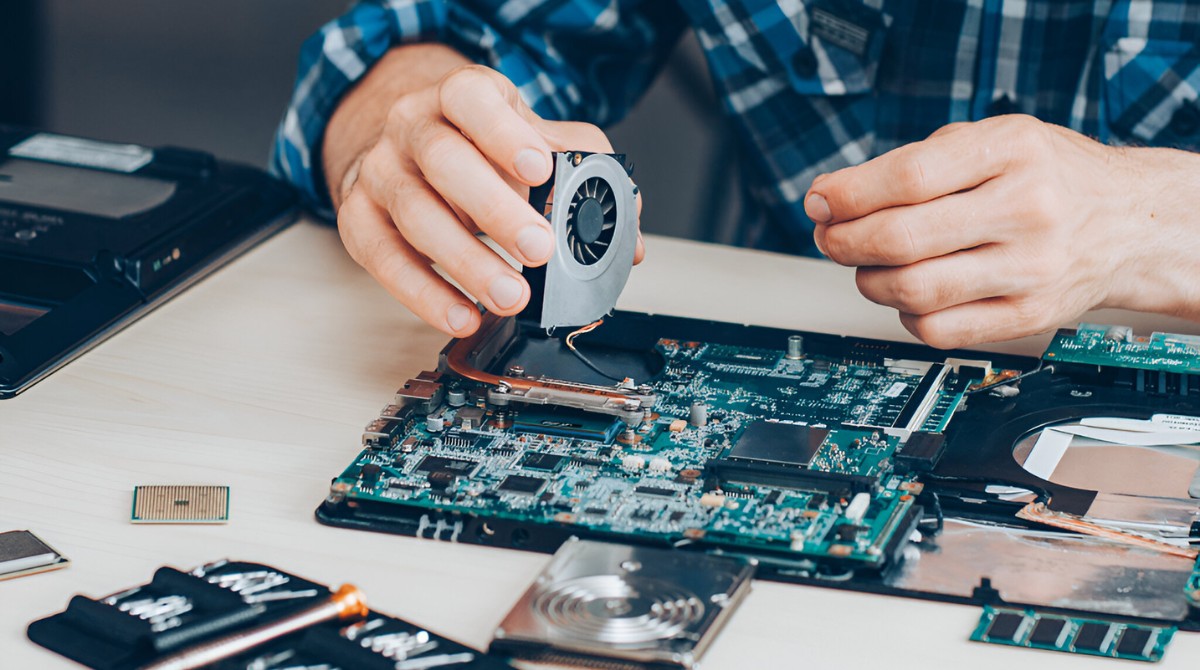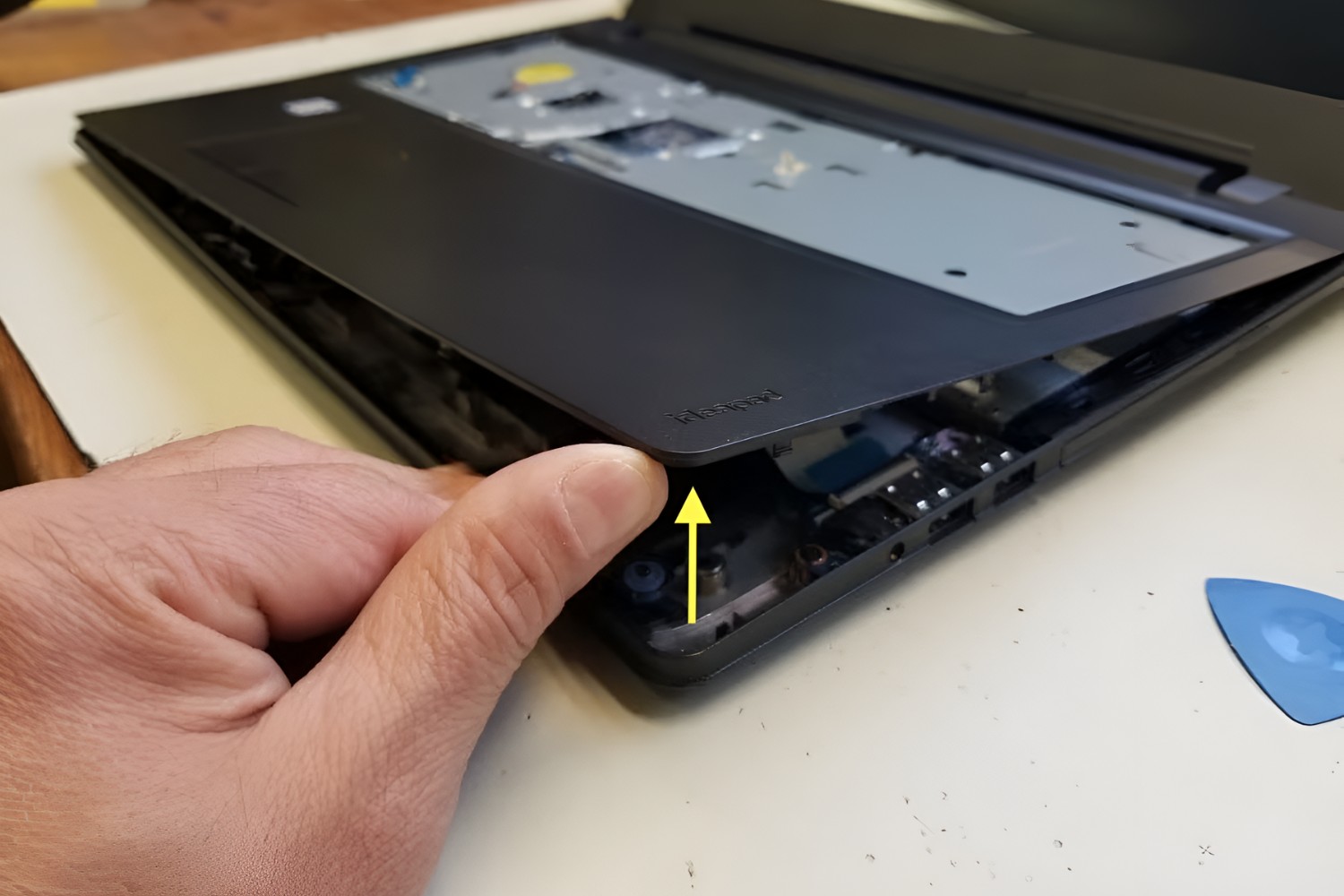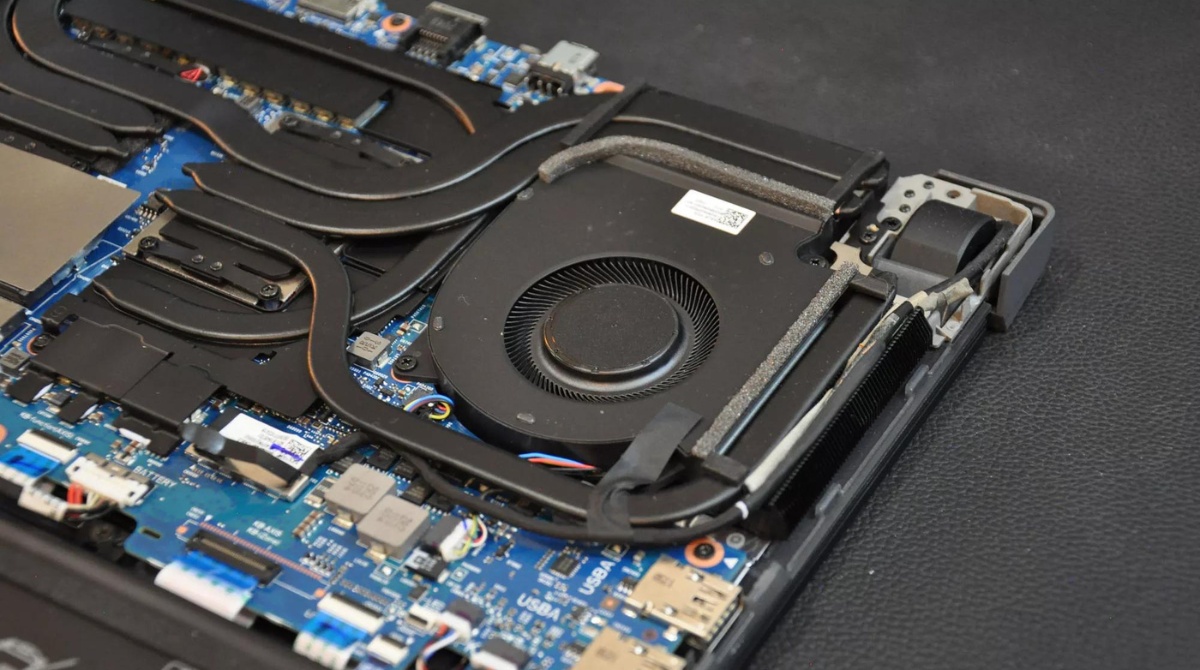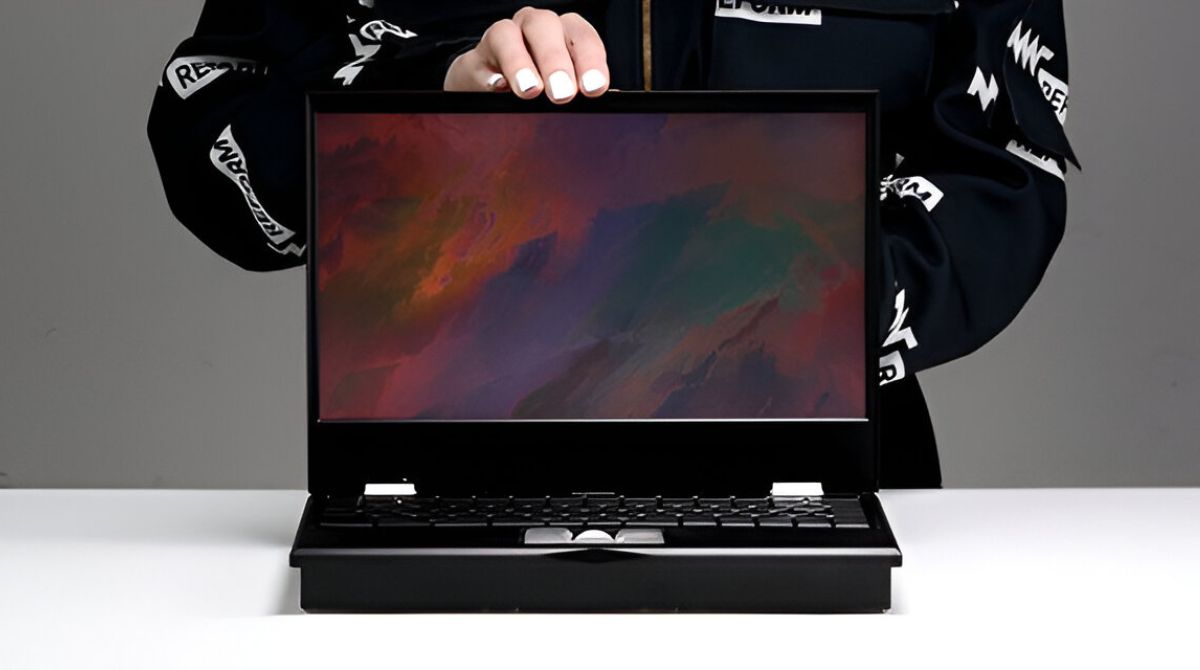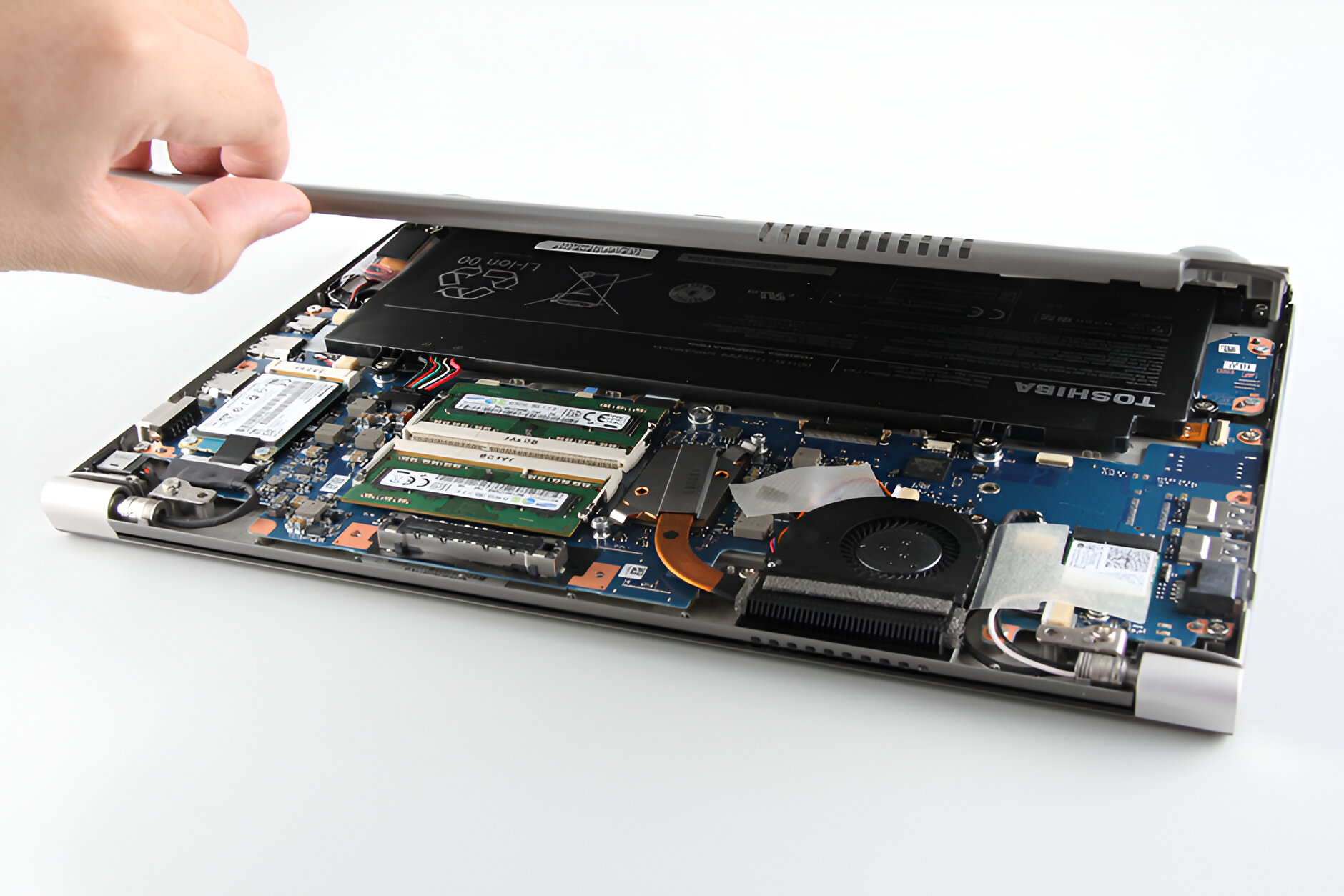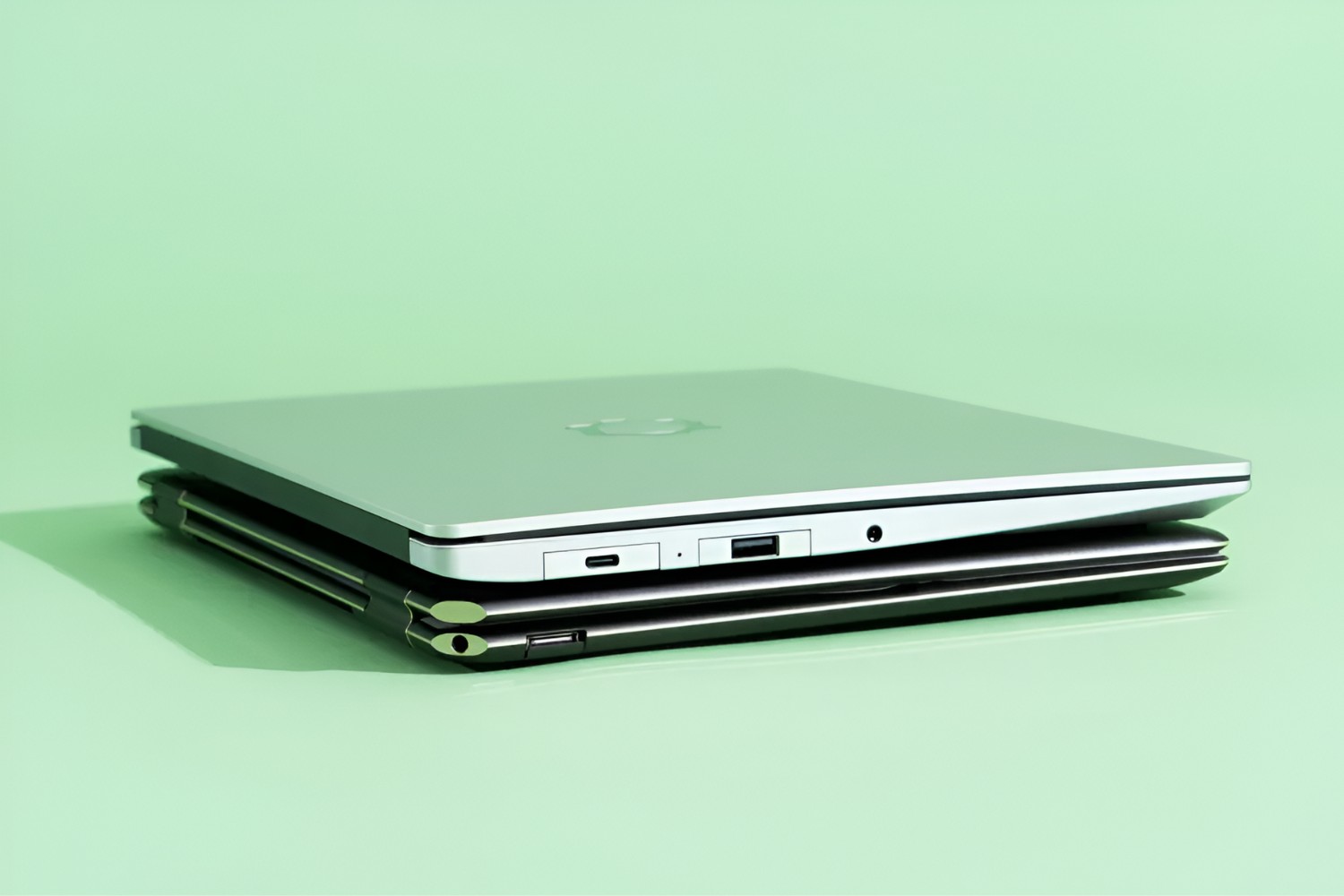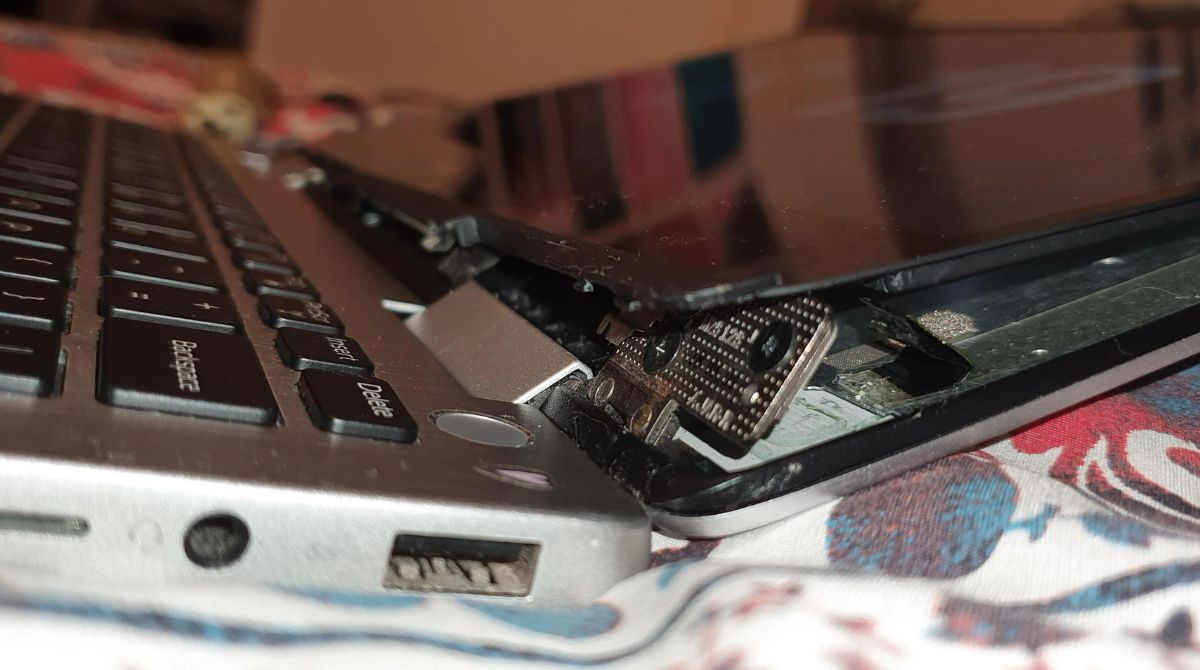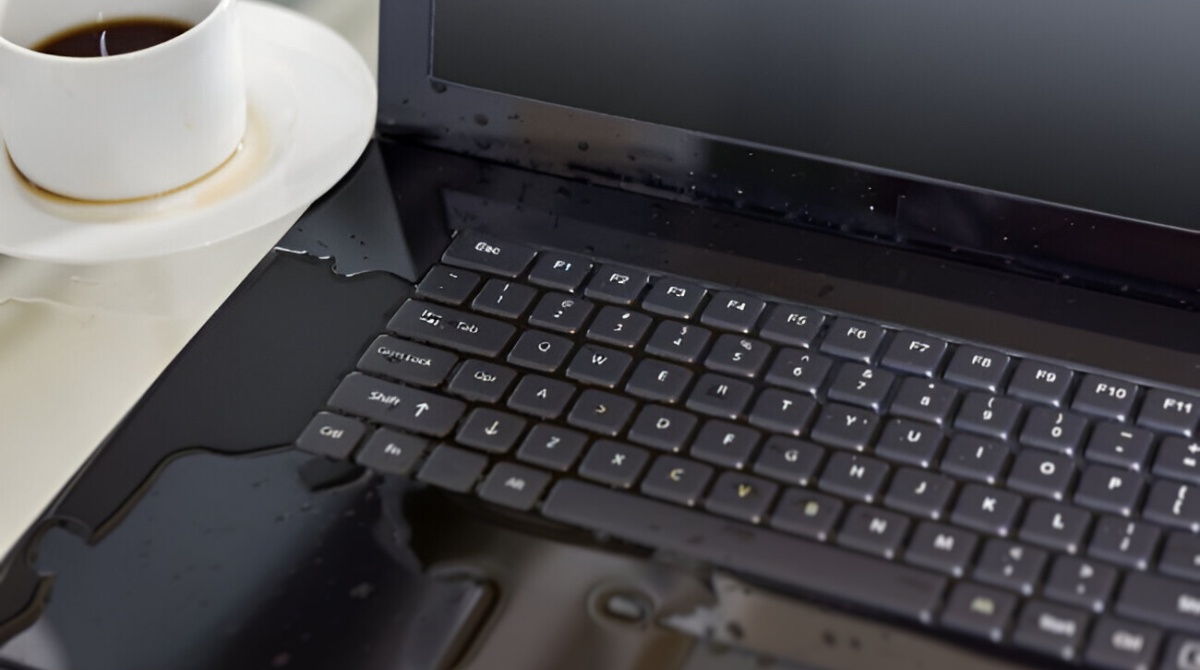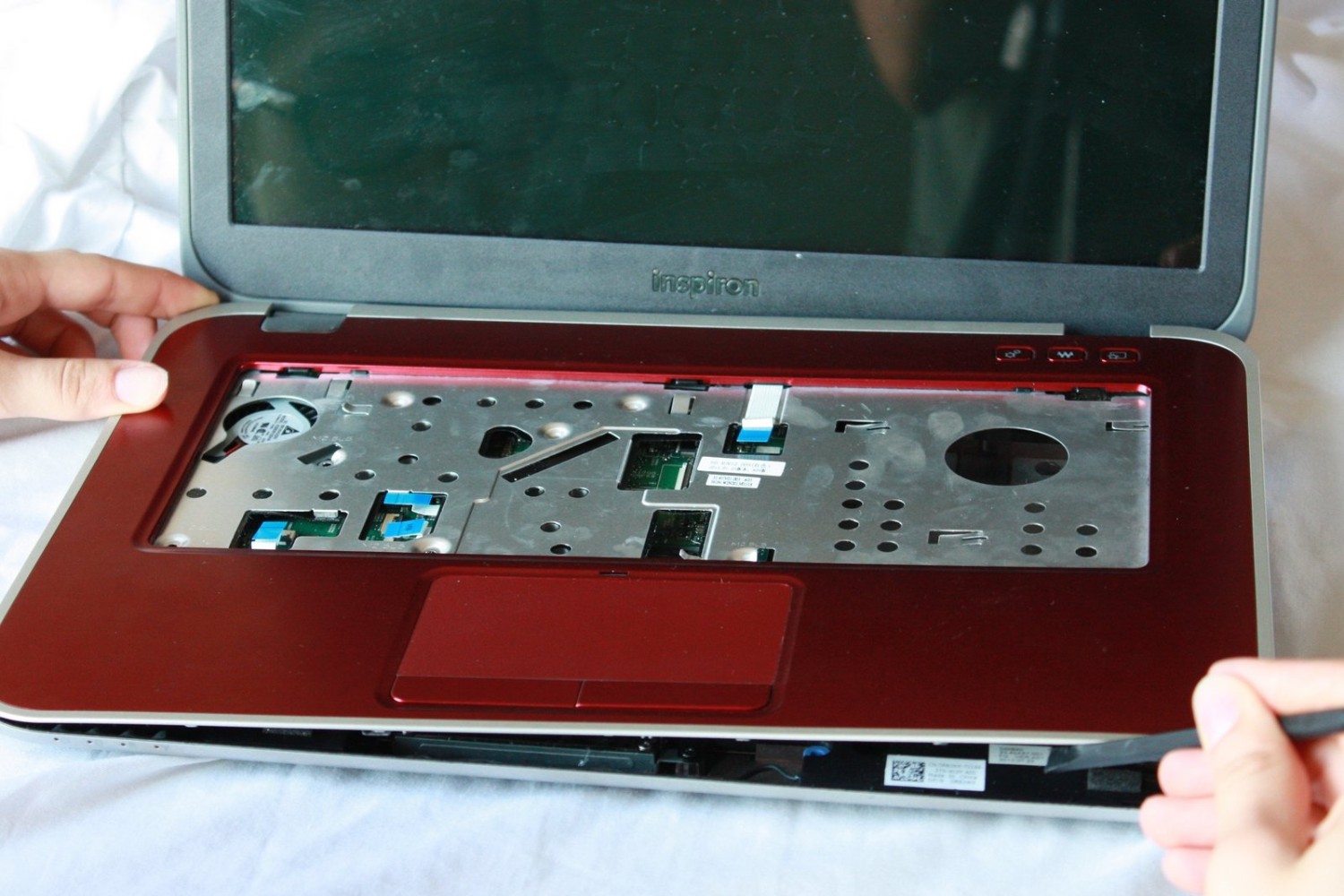Introduction
Welcome to the world of ultrabooks, sleek and compact laptops that offer high performance and portability. These cutting-edge devices have taken the market by storm, appealing to both casual users and professionals alike. But have you ever wondered what lies beneath the sleek exterior of an ultrabook? In this article, we will explore the internal components that power these remarkable machines.
Ultrabooks are designed to be thin and lightweight, without compromising on performance. They are equipped with powerful processors, ample memory, and high-speed storage, making them capable of handling a variety of tasks with ease. From the motherboard to the cooling system, each component plays a crucial role in ensuring smooth operation and optimal performance.
Understanding the internal parts of an ultrabook can help users make informed decisions when purchasing one. Whether you are a tech enthusiast or a novice user, this knowledge will enable you to appreciate the incredible engineering behind these remarkable devices. So, let’s dive into the fascinating world of ultrabook internals and discover what makes these devices tick.
Motherboard
The motherboard is the heart of an ultrabook, serving as a central hub that connects and controls all the internal components. It is a flat circuit board that houses the CPU, RAM, storage, and other essential components. The motherboard acts as a communication channel, allowing these components to interact and work together harmoniously.
Typically made of layers of fiberglass and copper traces, the motherboard provides electrical pathways for data transfer between components. It also contains various slots and connectors for expansion cards, such as graphics cards or Wi-Fi modules.
The motherboard’s size is specifically designed to fit within the compact enclosure of an ultrabook. Its compact design doesn’t compromise on functionality, as modern ultrabooks feature motherboards that pack a punch in terms of performance and connectivity.
Manufacturers carefully layout the motherboard components to optimize performance and thermal management. Components such as the CPU and RAM slots are strategically placed to provide efficient heat dissipation, leading to a cooler and more stable system.
The motherboard also plays a crucial role in determining the overall capabilities of an ultrabook. It dictates the number and type of ports available for connectivity, such as USB, HDMI, and Thunderbolt. Additionally, it determines the maximum amount of RAM and storage capacity the ultrabook can support, providing users with flexible options for customization and expansion.
Overall, the motherboard is the backbone of an ultrabook, connecting and coordinating all the internal components to ensure smooth operation and optimal performance. Without a high-quality motherboard, an ultrabook would struggle to deliver the fast and efficient computing experience that users expect.
Central Processing Unit (CPU)
The Central Processing Unit (CPU) is often considered the brain of an ultrabook. It is a small chip that performs the majority of the computational tasks required to run various applications and processes. The CPU consists of multiple cores, or processing units, that work together to execute instructions and manipulate data.
The performance of an ultrabook’s CPU is crucial for smooth multitasking, fast data processing, and seamless operation. Modern ultrabooks typically feature high-performance CPUs from Intel or AMD, which offer a balance between power efficiency and processing capabilities.
The CPU’s clock speed, measured in gigahertz (GHz), determines how quickly it can execute instructions. A higher clock speed generally translates to faster processing, enabling users to perform complex tasks and run demanding applications smoothly.
In addition to clock speed, the number of cores in a CPU also plays a significant role in its performance. Dual-core CPUs have two independent processing units, while quad-core CPUs have four. The more cores a CPU has, the more tasks it can handle simultaneously, resulting in improved multitasking and overall system responsiveness.
Furthermore, the CPU’s cache memory is crucial for quick data retrieval. The cache allows the CPU to store frequently accessed data, reducing the need to fetch it from RAM or storage. A larger cache size enhances the CPU’s performance by minimizing data latency and optimizing overall system speed.
Integrated Graphics Processing Unit (GPU) is another important component present in many modern ultrabook CPUs. It is responsible for rendering images and graphics, allowing users to enjoy high-quality visuals and play graphics-intensive games smoothly.
It’s worth noting that the CPU’s power consumption affects the overall battery life of an ultrabook. The latest generation CPUs are designed to be power-efficient, combining performance and energy-saving features to extend battery life without sacrificing processing capabilities.
To ensure optimal performance, it is important to choose an ultrabook with a CPU that suits your specific needs. Whether you’re a casual user requiring basic computing power or a professional demanding heavy performance for resource-intensive tasks, selecting the right CPU can make a significant difference in your overall computing experience.
Random Access Memory (RAM)
Random Access Memory, commonly known as RAM, is a vital component of an ultrabook’s internal architecture. It serves as temporary storage for data that the CPU needs to access quickly. The more RAM an ultrabook has, the more efficiently it can handle multiple tasks and run complex applications.
RAM is a type of volatile memory, meaning it loses its stored data when the power is turned off. This characteristic allows the CPU to quickly read and write data, providing the necessary resources for the smooth execution of programs.
The capacity of RAM determines the amount of data an ultrabook can hold and process at any given time. Ultrabooks typically come with varying RAM configurations, ranging from 4GB to 16GB or even higher. For basic tasks like web browsing and document editing, 8GB of RAM is generally sufficient. However, for more demanding tasks such as video editing or gaming, a higher RAM capacity is recommended to ensure smooth performance.
In addition to capacity, the speed of RAM also influences overall system performance. RAM speed is measured in megahertz (MHz) and indicates how quickly data can be accessed. Higher RAM speeds result in faster data retrieval, reducing latency and enhancing the system’s responsiveness.
It’s worth mentioning that RAM can be upgraded in some ultrabooks, allowing users to increase the capacity as their needs evolve. However, not all ultrabooks offer this flexibility, so it’s essential to consider your future requirements when choosing an ultrabook with expandable RAM options.
RAM works closely with the CPU to ensure efficient data transfer and processing. As the CPU executes instructions, it fetches data from the ultrabook’s storage and stores it temporarily in RAM for quick access. This seamless interaction between the CPU and RAM is critical for multitasking, running resource-intensive applications, and improving overall system performance.
Overall, RAM plays a crucial role in determining an ultrabook’s ability to handle multiple tasks simultaneously and provide a smooth computing experience. Alongside a powerful CPU and sufficient storage, a generous amount of RAM allows users to run demanding software and enjoy efficient multitasking without experiencing slowdowns or performance bottlenecks.
Solid-State Drive (SSD)
A Solid-State Drive (SSD) is a storage device that has become a standard component in modern ultrabooks. It provides high-speed, reliable, and efficient storage for the operating system, applications, and user data. Unlike traditional hard disk drives (HDDs), SSDs have no moving parts, which offers several advantages in terms of speed, durability, and power efficiency.
SSDs utilize flash memory to store and retrieve data quickly. This allows for faster boot times, rapid application launching, and improved overall system responsiveness. With an SSD, ultrabooks can read and write data significantly faster than with HDDs, resulting in reduced waiting times and improved user experience.
In addition to speed, SSDs are known for their durability. Since they lack mechanical components, they are more resistant to shock, vibration, and physical wear. This makes SSDs less prone to catastrophic failure, ensuring that your data remains safe and secure.
Another notable advantage of SSDs is their power efficiency. Compared to HDDs, SSDs consume less power, resulting in improved battery life for ultrabooks. This is particularly beneficial for users who require long-lasting battery performance and mobility.
SSDs come in various capacities, typically ranging from 128GB to 1TB or more. The storage capacity you choose depends on your specific needs and budget. Keep in mind that SSDs generally cost more per gigabyte compared to HDDs, but the benefits in terms of speed and reliability outweigh the price difference for most users.
Furthermore, SSDs contribute to the compact design of ultrabooks. Their smaller form factor allows for thinner and lighter laptops without compromising on storage capacity. This, combined with their improved performance, is one of the reasons why ultrabooks are highly portable and desirable for users on the go.
It’s important to note that while SSDs offer numerous advantages, they can come at a higher price compared to traditional HDDs. However, the performance benefits and enhanced user experience make SSDs a worthwhile investment for users who prioritize speed, durability, and power efficiency.
To sum up, the inclusion of an SSD in an ultrabook significantly enhances its performance, reliability, and efficiency. With faster data access, improved durability, and extended battery life, SSDs contribute to a superior computing experience, making them an integral part of today’s ultrabooks.
Battery
The battery is a critical component of an ultrabook that determines its portability and overall usage time. It provides the necessary power to keep the laptop running when it is not connected to an external power source. As ultrabooks are designed to be mobile devices, a reliable and long-lasting battery is essential for uninterrupted productivity and enjoyment.
Ultrabooks are equipped with lithium-ion (Li-ion) batteries due to their high energy density, lower self-discharge, and longer lifespan compared to other battery types. Li-ion batteries are also more compact and lightweight, allowing ultrabooks to maintain their slim and sleek form factor.
The battery life of an ultrabook varies depending on factors such as usage patterns, display brightness, CPU power consumption, and the efficiency of other components. Most ultrabooks offer a battery life of 8-12 hours on average, enabling users to work, stream media, or browse the web without the need for frequent recharging. Some premium ultrabooks even boast battery life upwards of 15 hours, catering to users with demanding requirements or those who are constantly on the move.
Modern ultrabooks often feature power-saving technologies aimed at prolonging battery life. These technologies include adaptive brightness control, which adjusts the screen brightness based on ambient lighting, and power management settings that optimize CPU performance for energy efficiency. These features help conserve battery power without sacrificing user experience.
Charging the battery of an ultrabook has also become more convenient with the adoption of USB-C ports. USB-C offers fast charging capabilities and compatibility with a range of power adapters, providing users with flexible charging options and allowing for rapid replenishment of the battery.
It is important to note that battery life can decrease over time as the battery undergoes charge cycles. Factors such as temperature and usage patterns can also affect battery health. However, manufacturers typically provide battery management software that can help optimize battery usage and extend its overall lifespan.
When choosing an ultrabook, considering the battery’s capacity and estimated runtime is essential, especially if you primarily use your laptop on the go or in places where power outlets may not be readily available. Additionally, checking for features like fast charging and power-saving technologies can further enhance the overall user experience and convenience.
In today’s fast-paced world, a long-lasting and efficient battery is vital for enhancing productivity and enabling seamless mobility. The battery technology in ultrabooks continues to evolve, providing users with improved performance and longer usage times to keep up with their demanding lifestyles.
Display Panel
The display panel is one of the most visually significant components of an ultrabook. It is responsible for presenting all the visual content, from text and images to videos and graphics. The quality and characteristics of the display panel greatly impact the overall user experience, making it a crucial aspect to consider when purchasing an ultrabook.
Ultrabooks come with various types of display panels, each with its own set of advantages and considerations. The most common types include LCD (Liquid Crystal Display) and OLED (Organic Light-Emitting Diode) panels.
LCD panels utilize a backlighting system to illuminate the pixels on the screen. They are known for providing accurate color reproduction and decent overall brightness. Ultrabooks with LCD panels often come with different resolutions, including Full HD (1920×1080), QHD (2560×1440), or even 4K (3840×2160). Higher resolutions result in sharper and more detailed visuals, but they may also impact battery life due to increased power consumption.
OLED panels, on the other hand, do not require a backlighting system. Instead, each pixel emits its own light, resulting in deeper blacks, vibrant colors, and excellent contrast ratios. OLED panels also have faster response times, making them well-suited for gaming and multimedia applications. However, OLED panels may be more prone to burn-in, which is a phenomenon where static images can leave a temporary or permanent imprint on the screen.
In addition to the panel type, other factors such as brightness, color accuracy, and viewing angles should also be considered. High brightness is essential for using the ultrabook in brightly lit environments, while accurate color reproduction is crucial for design or photo editing tasks. Wide viewing angles ensure that the screen remains clear and visible even when viewed from different perspectives.
Touchscreen functionality is also a feature to consider when selecting an ultrabook. Touchscreens provide a more intuitive and interactive user experience, allowing for gestures, pinching, and tapping, similar to operating a smartphone or tablet. Touchscreen ultrabooks are particularly convenient for tasks like navigating the operating system, drawing or taking notes, or using touch-based applications.
Lastly, the size of the display panel dictates the overall form factor of the ultrabook. Common display sizes range from 13 to 15 inches, with smaller sizes offering increased portability and larger sizes providing a more immersive viewing experience.
Considering your specific needs and preferences, it is important to choose an ultrabook with a display panel that matches your requirements. Whether you prioritize vibrant colors, sharp text, touch functionality, or portability, the display panel plays a critical role in enhancing the visual experience and overall usability of an ultrabook.
Graphics Card
The graphics card, also known as the GPU (Graphics Processing Unit), is a crucial component that determines the visual performance and capabilities of an ultrabook. It is responsible for rendering graphics, images, and videos, ensuring a smooth and immersive visual experience.
Most ultrabooks feature integrated graphics, which means that the GPU is integrated into the CPU. Integrated graphics provide basic graphics capabilities suitable for everyday tasks like web browsing, document editing, and multimedia playback. They consume less power and generate less heat, making them ideal for ultrabooks focused on portability and power efficiency.
However, some ultrabooks, especially those designed for gaming or graphic-intensive applications, may offer a dedicated graphics card. Dedicated GPUs, also known as discrete graphics cards, provide more powerful graphics processing capabilities. They have their own dedicated memory and processing units, allowing them to handle complex graphics tasks with ease. This makes dedicated graphics cards well-suited for gaming, video editing, 3D modeling, and other visually demanding applications.
One of the significant advantages of having a dedicated graphics card is the ability to play modern, graphically demanding games on your ultrabook. A powerful GPU enables you to enjoy high frame rates, realistic graphics, and smooth gameplay. It also allows for better performance when using professional software that relies heavily on graphics capabilities, such as CAD applications and video editing suites.
When considering a dedicated graphics card, aspects such as VRAM (Video Random Access Memory) and clock speed should be taken into account. VRAM is dedicated memory used by the GPU for storing and accessing graphics data quickly. Higher VRAM capacity allows for smoother gameplay and better performance in graphics-intensive tasks.
Graphics card clock speed, measured in megahertz (MHz), determines how fast the GPU can process and render graphics. A higher clock speed generally translates to better performance and smoother visuals.
It’s important to note that ultrabooks with dedicated graphics cards may consume more power and generate more heat compared to those with integrated graphics. This could impact battery life and overall system temperature. However, manufacturers often provide power management features to optimize GPU performance and minimize power consumption, ensuring a balance between performance and battery life.
If graphics performance is a priority for you, choosing an ultrabook with a dedicated graphics card is recommended. However, for general productivity and multimedia consumption, integrated graphics are typically sufficient.
Ultimately, the inclusion of a dedicated graphics card in an ultrabook provides a significant boost in graphics performance, allowing for gaming, multimedia creation, and other visually demanding tasks. It caters to users who require enhanced graphics capabilities for their work or entertainment, bringing a new level of visual richness and realism to the ultrabook experience.
Keyboard and Trackpad
The keyboard and trackpad are two essential input devices that greatly contribute to the functionality and usability of an ultrabook. These components enable users to navigate and interact with the operating system, applications, and content in a seamless and intuitive manner.
The keyboard of an ultrabook is specifically designed to provide a comfortable and efficient typing experience. It features a layout and key spacing that allows for quick and accurate typing, minimizing errors and maximizing productivity. Many ultrabook keyboards are backlit, making them easier to use in low-light environments and enhancing the overall aesthetics of the device.
Another key aspect of ultrabook keyboards is their tactile feedback. Typing on a keyboard with good tactile feedback provides a satisfying and responsive feel, facilitating a better typing experience. This is especially important for users who spend long hours typing or for professionals who require precise and fast typing, such as writers, programmers, or content creators.
The layout of the ultrabook keyboard may vary slightly depending on the manufacturer, but it generally includes all the standard keys found on a full-sized desktop keyboard. Some ultrabooks may also incorporate function keys or shortcut keys that provide easy access to specific functions or features. These can be customized and programmed to suit individual preferences or application-specific requirements.
The trackpad, also known as the touchpad, is the primary pointing device on an ultrabook. It allows users to move the cursor, perform gestures, and interact with the screen without the need for an external mouse. Like the keyboard, the trackpad is designed to be responsive and accurate, enabling precise control and smooth navigation.
Modern ultrabook trackpads often feature multi-touch functionality, allowing users to perform various gestures such as pinch-to-zoom, two-finger scrolling, and three-finger swiping. These gestures enhance productivity and streamline navigation, providing a more natural and intuitive user experience.
Size and smoothness are important considerations when evaluating the quality of a trackpad. A larger trackpad provides more space for gestures and navigation, while a smooth surface ensures that finger movements are recognized accurately. Additionally, some ultrabooks offer trackpads with integrated fingerprint readers for secure and convenient biometric authentication.
Backlit keyboards and trackpads with customizable settings are becoming more common in ultrabooks. Users can adjust brightness levels or customize key functions to suit their preferences and working environment, adding flexibility and personalization to the user experience.
Overall, the keyboard and trackpad of an ultrabook have a significant impact on daily usage and productivity. Ultrabook manufacturers strive to design and engineer keyboards and trackpads that offer comfort, accuracy, and a seamless user experience. Whether you’re typing a document, navigating the interface, or performing gestures, the quality and functionality of these input devices are essential for a satisfying and efficient computing experience.
Wi-Fi and Bluetooth Module
The Wi-Fi and Bluetooth module is a crucial component of an ultrabook that allows for wireless connectivity and communication. It enables users to connect to wireless networks for internet access, as well as wirelessly connect to other devices such as headphones, speakers, smartphones, and more.
Wi-Fi is a wireless networking technology that provides high-speed internet access. Ultrabooks are typically equipped with the latest Wi-Fi standards, such as Wi-Fi 5 (802.11ac) or Wi-Fi 6 (802.11ax), offering faster transfer speeds, improved range, and enhanced reliability compared to previous generations.
The Wi-Fi module in an ultrabook connects to Wi-Fi networks, allowing users to browse the web, stream media, download files, and engage in online activities. The availability of fast and reliable Wi-Fi connectivity is essential, especially for users who rely on cloud-based applications, online collaboration, or remote working.
Bluetooth, on the other hand, is a short-range wireless technology that enables communication and data transfer between devices. Ultrabooks typically come with Bluetooth connectivity, allowing users to connect wireless peripherals like keyboards, mice, and speakers, as well as transfer files to and from smartphones or tablets.
Bluetooth technology also enables the convenience of wireless audio, as ultrabook users can connect to Bluetooth-enabled headphones or speakers for a wire-free audio experience. This is particularly helpful for multimedia consumption, video conferencing, or enjoying music without the clutter of cables.
Both Wi-Fi and Bluetooth modules are integrated into the ultrabook’s hardware, typically in the form of a small chip or module connected to the motherboard. This integration ensures seamless and reliable connectivity, eliminating the need for external adapters or dongles.
When choosing an ultrabook, it’s important to consider the Wi-Fi and Bluetooth capabilities. Look for ultrabooks that support the latest Wi-Fi standards for improved performance, especially if you have a high-speed internet connection. Additionally, ensure that the ultrabook has Bluetooth connectivity with an updated version to ensure compatibility with a wide range of devices and peripherals.
As wireless connectivity continues to evolve, ultrabook manufacturers strive to provide reliable and fast wireless capabilities to facilitate seamless communication and connectivity. The Wi-Fi and Bluetooth modules allow ultrabook users to stay connected, collaborate, and interact with devices and networks wirelessly, enhancing productivity and convenience in the digital age.
Cooling System
The cooling system is an essential component of an ultrabook that ensures proper thermal management and prevents the device from overheating. Ultrabooks are designed to be slim and compact, which presents unique challenges in terms of heat dissipation. The cooling system, therefore, plays a crucial role in maintaining optimal performance and preventing damage to internal components.
Ultrabooks typically employ a combination of passive and active cooling mechanisms to keep temperatures within acceptable limits. Passive cooling involves the use of heat sinks and thermal pads to absorb and dissipate heat passively. These are strategically placed on critical components such as the CPU, GPU, and other high-power elements.
Active cooling, on the other hand, relies on the use of small fans or blowers to force air through the device and carry away heat. These fans draw cool air from the surroundings and channel it over the heat-generating components. The hot air is then expelled through the vents or heat outlets on the sides or rear of the ultrabook.
The cooling system is carefully engineered to ensure efficient heat dissipation while maintaining a compact form factor. The placement of heat sinks, vents, and fans is optimized to maximize airflow and minimize the risk of hotspots. The design also considers factors such as noise reduction, power consumption, and performance balance to provide an optimal cooling solution.
In addition to the physical cooling components, ultrabooks often use intelligent software controls to regulate fan speeds and monitor temperature levels. These controls adjust fan speeds based on the workload, ensuring that cooling is provided when needed and minimizing noise when the system is under low load.
It’s worth noting that the cooling system’s efficiency can impact the overall performance of the ultrabook. An inadequate cooling system may result in throttling, where the CPU and GPU reduce their performance to prevent overheating. This can lead to decreased performance and a less enjoyable user experience.
Manufacturers continuously strive to improve the cooling systems in ultrabooks by utilizing advanced materials, enhancing heat dissipation techniques, and optimizing airflow. This ensures that ultrabooks can handle demanding tasks, such as gaming or video editing, without compromising on performance or risking component damage due to excessive heat buildup.
When choosing an ultrabook, considering the cooling system’s effectiveness is important, especially if you plan to use the device for resource-intensive tasks. Look for ultrabooks with efficient cooling designs and positive user reviews regarding temperature management to ensure a reliable and stable performance under varying workloads.
The cooling system in an ultrabook is a critical aspect that contributes to its longevity and reliable operation. It ensures that the device remains cool even during extended use, protecting internal components and delivering consistent performance for an optimal user experience.
Speakers
The speakers in an ultrabook are responsible for delivering audio output, allowing users to enjoy music, videos, and other multimedia content. While ultrabooks prioritize sleekness and portability, the inclusion of high-quality speakers is crucial to provide a satisfactory auditory experience.
Due to the compact design of ultrabooks, the speakers are generally smaller compared to those in larger laptops or external speakers. Despite their size limitations, manufacturers employ various techniques to optimize audio quality and maximize sound output.
Stereophonic sound, commonly known as stereo sound, is the standard for ultrabooks. This system utilizes two speakers to reproduce sound with a sense of left and right channel separation, enabling a more immersive audio experience. The speakers are often strategically positioned on either side of the keyboard or at the bottom of the laptop for optimal sound dispersion.
Audio enhancement technologies are also utilized in ultrabook speakers to improve the audio output. These technologies can include equalization (EQ) adjustments, noise cancellation, spatial audio, and bass enhancement. These features optimize the sound quality, providing clearer and more balanced audio reproduction.
While built-in speakers are convenient, connecting external audio devices, such as headphones or external speakers, can enhance the audio experience even further. Ultrabooks usually come equipped with headphone jacks or Bluetooth connectivity, allowing users to connect their preferred audio output devices for a more immersive sound experience.
It’s worth noting that the audio quality of ultrabook speakers can vary depending on the specific model and manufacturer. To ensure a satisfactory audio experience, it’s advisable to read reviews or listen to audio samples to assess the quality and loudness of the built-in speakers before making a purchasing decision.
Furthermore, advancements in audio technology have led to the integration of virtual assistants, such as Microsoft’s Cortana or Apple’s Siri, with built-in microphones. These microphones allow users to interact with their ultrabooks using voice commands, enhancing functionality and convenience.
Ultimately, while ultrabooks prioritize portability and sleek design, the speakers within these devices are engineered to deliver an audio experience that complements the visual experience. While they may not offer the same power and depth as external speakers, high-quality ultrabook speakers contribute significantly to a satisfying multimedia experience on the go.
Camera
The camera is an integral component of an ultrabook, enabling users to capture photos, record videos, and engage in video conferencing or online communication. While ultrabooks are primarily designed for portability and productivity, the inclusion of a camera allows users to stay connected and visually interact with others.
Ultrabook cameras are typically positioned above the display panel, allowing for convenient usage during video calls and capturing selfies. Most ultrabook cameras support high-definition (HD) or even Full HD resolution, ensuring clear and sharp visuals during video recording or conferencing.
The quality of the camera sensor, along with its specifications, such as megapixel count and image processing capabilities, plays a significant role in determining the camera’s performance. A higher megapixel count generally translates to more detailed and higher-quality images and videos.
While ultrabook cameras are primarily designed for video conferencing and casual photography, they may not match the image quality and versatility of standalone or dedicated cameras. However, they provide sufficient capability for everyday usage, such as taking snapshots, participating in online meetings, or recording short videos for social media.
Some ultrabooks also incorporate additional features like autofocus, which ensures that the subject remains clear and well-focused, even during movement. This can be particularly useful during video calls or capturing subjects in motion.
With the rise of remote work and online education, the camera has gained even more prominence in ultrabooks as it enables face-to-face communication, collaboration, and virtual learning. The camera quality and performance, coupled with other audio technologies like microphones and built-in speakers, contribute to a seamless and immersive experience during video conferencing and online meetings.
It is important to note that privacy and security concerns are associated with built-in cameras, particularly for those who value their privacy or utilize their devices in sensitive settings. Manufacturers often provide physical camera shutters or software controls to ensure privacy and protect users from unauthorized access.
While the camera on an ultrabook may not be the primary focus, it complements the overall functionality and versatility of the device. Whether it’s for capturing memorable moments, participating in virtual meetings, or engaging in video communication, the camera in an ultrabook facilitates visual interaction and enhances the overall experience of the device.
Ports and Connectivity Options
The ports and connectivity options in an ultrabook are crucial for expanding its functionality and connecting to a wide range of devices and peripherals. Despite the slim and compact design of ultrabooks, manufacturers strive to include a variety of ports to ensure versatility and compatibility.
One of the most common ports found in ultrabooks is the USB (Universal Serial Bus) port. USB ports allow for connecting external devices such as flash drives, external hard drives, smartphones, digital cameras, and other peripherals. Ultrabooks usually come equipped with USB-A ports, which are the standard USB ports found on most devices, as well as USB-C ports, which offer faster data transfer speeds and versatility in terms of device connectivity and power delivery.
HDMI (High-Definition Multimedia Interface) ports are also common in ultrabooks, enabling users to connect their laptops to external displays, projectors, or TVs. This allows for larger screen real estate for productivity, gaming, or multimedia consumption.
To connect to wired networks, most ultrabooks feature an Ethernet port, although this port is becoming less common as wireless networking becomes more prevalent. Additionally, an SD card slot is often included, allowing users to transfer photos and videos from their digital cameras or other devices directly to their ultrabook.
Ultrabooks also include a 3.5mm headphone jack, enabling users to connect their favorite wired headphones or external speakers for audio output. Some ultrabooks offer additional connectivity options, such as a Thunderbolt port, which provides high-speed data transfer, video output, and power delivery capabilities in a single connector.
Wireless connectivity options, such as Wi-Fi and Bluetooth, have been discussed in previous sections. These wireless technologies enable users to connect to wireless networks, as well as pair their ultrabooks with Bluetooth-enabled devices like headphones, speakers, or smartphones.
It is important to note that not all ultrabooks include every port and connectivity option. As ultrabooks prioritize sleekness and portability, some models may offer a limited selection of ports or rely more heavily on USB-C or wireless connectivity for device pairing and external device connection.
When choosing an ultrabook, it is essential to evaluate your specific connectivity needs and assess which ports and options are necessary for your intended usage. Consider the devices and peripherals you regularly use and ensure that the ultrabook provides the necessary ports to connect to them without the need for additional adapters or dongles.
Ultrabooks have become increasingly versatile over the years, offering a range of ports and connectivity options to cater to various user needs. Whether it’s connecting to external displays, transferring data to external storage, or pairing with wireless devices, the ports and connectivity options in an ultrabook enhance its functionality and expand its capabilities.
Conclusion
Ultrabooks are sleek, lightweight, and powerful devices that have revolutionized the laptop market. In this article, we explored the internal components that make ultrabooks tick, providing a deeper understanding of their functionality and capabilities.
We began by delving into the motherboard, the central hub that connects and coordinates all the internal components of an ultrabook. The CPU, RAM, SSD, and graphics card were discussed, highlighting their roles in delivering fast and efficient performance.
We then explored other essential components, such as the battery, display panel, keyboard, trackpad, Wi-Fi, and Bluetooth modules, speakers, camera, and ports. These components contribute to the overall user experience, allowing for portability, connectivity, multimedia enjoyment, and productivity.
The cooling system plays a crucial role in maintaining optimal performance by managing heat dissipation and preventing the ultrabook from overheating. Additionally, the conclusion highlighted the importance of the camera in facilitating visual communication and capturing moments, as well as the versatility provided by various ports and connectivity options.
When choosing an ultrabook, it’s important to consider your specific needs and requirements. Assessing factors such as processor performance, memory capacity, storage options, display quality, battery life, audio capabilities, and connectivity options will help you find an ultrabook that matches your preferences and usage patterns.
While ultrabooks excel in portability and performance, it’s worth noting that trade-offs are made to achieve their slim design. Certain features or specifications, such as upgradability or dedicated graphics, may vary between models and might impact the overall user experience.
Ultrabooks continue to evolve and push the boundaries of portable computing, offering impressive power, stunning visuals, and long-lasting battery life. As technology advances, it’s exciting to see how future ultrabooks will further enhance productivity, creativity, and entertainment.
With the knowledge gained from understanding the internal components of an ultrabook, users can make informed decisions when purchasing an ultrabook that best suits their needs and preferences. Whether for professional use, creative pursuits, or casual computing, ultrabooks provide a powerful and versatile computing experience in a compact and stylish package.







